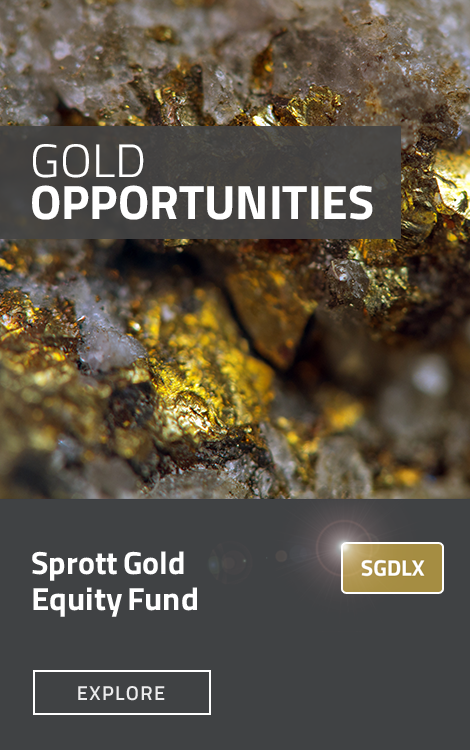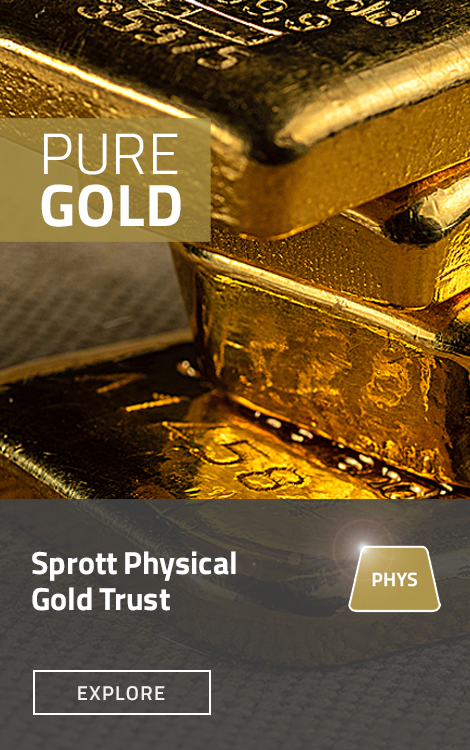Here, we strive to answer one of the biggest questions our clients and potential investors have today:
Did I Miss the Gold Move?
It is hardly a secret that gold and gold mining stocks have generated significant outperformance relative to the S&P 500 Index on a year-to-date basis. Still, many would be surprised that the outperformance also pertains to trailing 3, 5 and 10-year intervals. The impressive accomplishment has occurred despite minimal participation by the vast majority of institutional and individual investors.
History is one thing. The relevant question is whether it is too late to invest? We believe that precious metals equities still offer considerable upside based on (1) their demonstrable undervaluation, (2) the lack of widespread participation and (3) the excellent potential for further advances in the gold price.
In our view, further substantial upside remains, and we believe gold and precious metals should constitute core strategic investment positions, similar to the conventional wisdom of the 1960s and 1970s. However, given sizzling recent gains in the precious metals sector, shakeouts will inevitably occur.
1. It’s Not Too Late to Invest in Physical Gold and Gold Mining Equities
By wide margins, both physical gold (+47.04%) and gold mining stocks (+122.57%) have outperformed the S&P 500 Index (+13.72%) year-to-date through September 30, 2025. Extended out to even longer periods, as shown in Figure 1, the performance of gold and gold stocks is equally impressive.
Figure 1. Gold Equities and Gold Have Posted Strong Returns vs. the S&P 500 Index
Cumulative Returns for Periods Ending 9/30/2025
Source: Bloomberg. Period from 9/30/2015-9/30/2025. Gold mining equities are measured by the GDM Index (NYSE Arca Gold Miners Index). Gold Bullion is measured by GOLDS Comdty Spot Price. The S&P 500 Index is measured by the SPX. You cannot invest directly in an index. Past performance is no guarantee of future results.
For the past five years, mining stocks have predominantly attracted deep-value, contrarian investors. Looking closely at the largest gold mining ETF, VanEck Gold Miners ETF (GDX)1, there have been net outflows in outstanding shares over the past two years (see Figure 2, red line). GDX has lost nearly a quarter of its units year-to-date in 2025 and nearly a third of its units since 2024.
2. Gold Is Not a Crowded Trade
As a wider array of investors takes notice and gold mining equities attract inflows, we believe there is potential for substantial further upside. It has only been since December 2024 that mining stocks have broken out of a powerful multi-year consolidation pattern (see blue line). In our opinion, mining stocks are transitioning from pariah status to momentum plays as leverage to a bullish outlook2 for gold prices. Despite strong gains this year, precious metals equities remain modestly valued.
Figure 2. GDX ETF Has Experienced Substantial Outflows Since 2024
Source: Bloomberg. Data as of 9/30/2025.
When viewed through the lens of negative investor flows and discounted valuations, descriptors like “crowded,” “overbought” and “overheated” do not hold water.
Gold mining stocks currently have an aggregate market capitalization of approximately $550 billion compared to the global equity market capitalization of $128 trillion, or 0.43%.3 At its high in 2011, this figure was 0.7%. As of August 2025, the MAG Seven4 represented 34% of the S&P 500.5
Mining stocks (of which gold mining equities are a small subset) are now at their smallest share of global equities since 1900.
Figure 3.
Source: Statista, S&P Global Market Intelligence, Tavi Costa, Crescat Capital.
3. Gold Displacing Fixed Income in Risk Parity Portfolio Models
Mike Wilson, CIO of Morgan Stanley, recently recommended (Reuters 9/16/2025) replacing the traditional 60/40 risk mitigation model portfolio with a 60/20/20 portfolio consisting of 60% equities, 20% fixed income and 20% gold.6 In a similar vein, in May 2025, Goldman Sachs noted “the recent failure of U.S. bonds to protect against equity downside” and concluded that replacing some bond exposure with gold could enhance returns over a five-year horizon.7
Figure 4. The 60/20/20 Portfolio
Exposure to physical gold is a risk diversification tool, while the investment objective in mining stocks is to capture alpha8 to the broader market in the form of directional leverage to rising gold prices. The proper allocation depends on the specific investment objectives of the client or investor.
The normally expected outperformance has only barely started during the past two years, as worries around cost inflation have faded for the miners. In our opinion, gold mining shares still have substantial “catch-up” potential relative to the gains in bullion.
4. Gold Mining Company Management Has Improved Significantly
Based on our research teams’ conversations with the management teams of over 100 companies, we observe that the overwhelming focus is on return on capital, returning excess capital to shareholders in the form of dividend increases or share buybacks, and disciplined capital allocation. This contrasts with the decade-ago mentality of “growth at any price.”
Back then, the industry was seen as having squandered shareholder value by making reckless and costly acquisitions during a period of high gold prices. Many mining firms prioritized increasing gold output at any cost, rather than focusing on per-share value. This was compounded by falling gold grades in their mines, requiring higher investment to produce the same amount of gold.
The management of gold mining companies has undergone significant improvement through the adoption of advanced technology, a greater focus on operational excellence and an increased emphasis on environmental factors. Rising costs, pressure from investors and the public, and a decline in the discovery of new high-grade gold deposits have driven these changes.
5. Potential Value Contribution of Active vs. Passive Management
Based on our detailed research on individual companies, we overweight our highest conviction investment ideas, in many cases resulting in substantially different exposures relative to passive indices. We focus on mid- and smaller-cap companies, primarily based on valuation, as well as special factors such as potential M&A activity or exceptional growth.
Sprott’s active portfolio managers have the potential to add value through selective stock picking and thoughtful portfolio construction. The 171% average performance spread between top and bottom-tier precious metals miners over the past five years underscores the potential advantage of active management (see Figure 5).
Figure 5. The Active Management Opportunity: Gold Miners Have a Wide Range of Performance
Source: Bloomberg and FactSet as of 12/31/2024. Gold Miners (GDM) represents the NYSE Arca Gold Miners Index (GDMNTR INDEX) and the ~45 constituents of GDX US Equity, which tracks the GDMNTR Index. You cannot invest directly in an index. Past performance is no guarantee of future results.
6. Where Does Silver Fit In?
Silver has lagged gold over the past decade. Flash forward to today, and several years of deficits in silver have led to extreme market tightness, and silver has been outperforming strongly, up ~27% thus far in Q3 and 61.39%% YTD as of 9/30/2025, reaching 15-year highs and approaching its all-time high (~$49), made back in 2011.
Despite this recent catch-up performance with respect to gold, the gold-to-silver ratio at 83x still sits above its historic average of ~67x (see Figure 6).9 Helping to support silver strength, there has been chronic underinvestment in the sector over the last decade, highlighted by a stark scarcity of new silver discoveries.
A breakout to new silver price highs (to compensate for the improved gold price), along with a re-rate of the silver equities to long-term averages (and a catch-up to their gold-producing peers), would be in keeping with the latter half of previous precious metal bull markets.
Figure 6. The Gold/Silver Ratio Is Measurably Above its Historic Average (1980-2025)
Source: Bloomberg. Data as of 9/30/2025.
A Compelling Case for a Strategic Allocation
Gold and gold mining equities have delivered meaningful outperformance, yet we believe the opportunity remains underappreciated. Tepid investor flows, discounted valuations and the structural need for diversification suggest that capital allocation to the sector is still in its early stages.
Importantly, silver also presents significant catch-up potential, supported by chronic underinvestment, supply deficits and its dual role as both a monetary and industrial metal. With disciplined management, improved balance sheets and leverage to higher precious metal prices, gold miners appear to be better positioned than in prior cycles. In our view, physical bullion and selective active exposure to mining equities—including both gold and silver producers—offer a compelling case for strategic allocation.
The desire for gold is not for gold. It is for the means of freedom and benefit. (Ralph Waldo Emerson)
| 1 | VanEck Gold Miners ETF (GDX®) seeks to replicate the price and yield performance of the MarketVector Global Gold Miners Index (MVGDXTR), which is intended to track the overall performance of companies involved in the gold mining industry. |
| 2 | “Bullish" means having a confident and optimistic outlook, especially regarding an investment, market or the economy, expecting prices to rise or success to be achieved. |
| 3 | Source: Bank of America. Bank of America sees nearly $1 trillion market cap potential for gold miners. Kitco.com, 9/15/2025 |
| 4 | The Mag Seven (or Magnificent 7) refers to seven leading technology companies (Alphabet, Amazon, Apple, Meta, Microsoft, Nvidia, and Tesla) that have a significant impact on the stock market and have achieved massive market capitalizations, often over $1 trillion. |
| 5 | Source: Forbes. S&P 500's Weight In Mag 7 Stocks Passes 30%. Is This A Diversification Risk? 8/26/2025. |
| 6 | Source: Morgan Stanley CIO favors 60/20/20 portfolio strategy with gold as inflation hedge, 9/17/2025. |
| 7 | Source: Goldman Sachs, Why Investors Should Hedge with Gold and Other Commodities, 9/25/2025. |
| 8 | In terms of investment performance, alpha measures an investment's risk-adjusted excess return compared to a benchmark index. |
| 9 | The gold-to-silver ratio measures how many ounces of silver it takes to buy one ounce of gold; it's calculated by dividing the current price of gold by the price of silver. |
Investment Risks and Important Disclosure
The exact percentage of physical gold and gold equities in an investment portfolio depends on several factors including an investor’s risk tolerance, investment objectives, time horizon, income requirements and overall financial situation. Investing in gold and gold equities involves additional risks like the possibility for substantial price fluctuations over a short period of time and a relatively limited and unregulated market. Sources of gold are concentrated in countries with the potential for political instability.
Relative to other sectors, precious metals and natural resources investments have higher headline risk and are more sensitive to changes in economic data, political or regulatory events, and underlying commodity price fluctuations. Risks related to extraction, storage and liquidity should also be considered.
Gold and precious metals are referred to with terms of art like "store of value," "safe haven" and "safe asset." These terms should not be construed to guarantee any form of investment safety. While “safe” assets like gold, Treasuries, money market funds and cash generally do not carry a high risk of loss relative to other asset classes, any asset may lose value, which may involve the complete loss of invested principal.
Past performance is no guarantee of future results. You cannot invest directly in an index. Investments, commentary and opinions are unique and may not be reflective of any other Sprott entity or affiliate. Forward-looking language should not be construed as predictive. While third-party sources are believed to be reliable, Sprott makes no guarantee as to their accuracy or timeliness. This information does not constitute an offer or solicitation and may not be relied upon or considered to be the rendering of tax, legal, accounting or professional advice.
Company names (including those in Appendix A) should not be construed as investment recommendations to buy, sell or hold any particular security. There is no guarantee that the companies were or will be profitable and reference to them is meant only to broadly illustrate the relative financial situation of gold mining companies as generally indicated by share buyback announcements, dividend hikes, or both, year-to-date.










